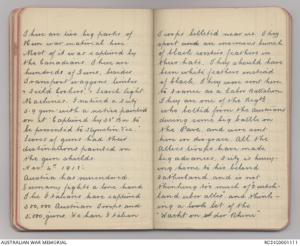First World War diaries and letters get new life online

Eyewitness accounts of the end of the First World War, as recorded in diaries and letters, are now available online as part of a major digitisation project led by the Australian War Memorial.
These diaries and letters give an intimate insight to this globally significant day, as Australians gather to mark Remembrance Day and commemorate the Armistice of the First World War, which was signed at 11 am on 11 November 1918.
“The Memorial has a multitude of original letters and diaries that express how people felt about the signing of the Armistice and the war coming to an end,” Australian War Memorial Research Centre head Robyn Van Dyk said.
“Many of the letters and diaries on the Memorial’s website record how people reacted to hearing of the end of a very long and horrific war. Some also took part in and recorded various celebrations.
“Many wrote about their relief of not having to fight anymore, for others there was a hint of disbelief.
“Others reflected on the loss of friends and family.”
In one example, Lieutenant Sydney Traill wrote on the 11 November 1918: “It was officially announced late tonight that hostilities have ceased as from 11 o’c a.m. today. We knew early in the morning, though. No one displayed the slightest enthusiasm and it doesn’t matter a tuppeny dump to me now, whether it goes on or not, the war has done its worst for our family.”
Another example includes 18-year-old Australian Private Gallwey who wrote: “London has gone mad and I am intoxicated with joy.”
The First World War collections of diaries and letters are part of the Memorial’s four-year digitisation project.
“Digitisation makes these collections so much more accessible to everyone,” Ms Van Dyk said.
“There are over 14,000 collections that have been digitised including archival records, photographs, film, maps, art posters and objects, all now being progressively published.
“In the past, people had to travel to Canberra and request to view these items which were only able to be viewed from the Reading Room but now you can access these historic records from home and unlike paper you can zoom into the text and bring up the content in detail.
“Personal collections such as letters and diaries give us a deep insight into how many Australians felt, you get a sense of what it was like for those individuals.
“Thanks to this project more and more of these collections can now be accessed online.”
To find more historical gems use collection search to discover them online.
